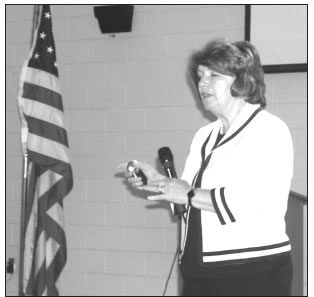|
Related story |
Even while drug use declines significantly among public-school students and a recent Washington State Supreme Court decision casts doubt on the legality of random drug testing, President George Bush’s administration continues to campaign for more “suspicionless” student testing.
As part of that effort, Bertha Madras, deputy director for demand reduction in the White House Office of National Drug Control Policy, and several assistants came to Pagosa Springs, Colo., on April 24 to address a forum hosted by the Promoting Prevention Coalition, a local group dedicated to reducing student drug use.
“In our society, we have 2.5 million people who used drugs — young people between ages 12 to 17 — in the past 30 years,” said Madras, dubbed the “drug czarina” by ONDCP. “No. 1 is marijuana and racing very quickly up after it is prescription drugs,” mainly opiate-based painkillers.

Bertha Madras of the White House Office of National Drug Control Policy argues for random student drug testing in Pagosa Springs, Colo., recently. Photo by David Grant Long.
“But we do have good news,” she added, “Overall drug use has dropped 24 percent, with marijuana about the same [and] steriod use is down, ecstasy is down, meth is down, cigarettes is down — we have seen a very dramatic decline in the past five years, but it’s still not enough.”
Drug use affects people from before birth to old age, Madras said, in ways ranging from premature births to developmental problems to parental neglect and abuse, which she said studies had found was tied to “alcohol and illicit drugs” in 70 percent of cases. (Although Madras made no distinction, alcohol is by far the most common drug of abuse among teenagers and adults alike, according to ONDCP studies as well as many others.)
Madras stressed, however, her emphasis was primarily on the welfare of middle- and high-school students.
And in Colorado, she said, two studies with “conflicting information . . . are still good enough for us to feel concerned that 25 percent of 12thgraders have used illicit drugs in the past 30 days, and the CDC [Centers for Disease Control] has an even higher number. So they’re all going down, but we’re not doing enough.” (Curiously, the CDC also noted that during the recent period of drug-use decline “the percentage of schools that had or participated in a community-based illegal drug-use prevention program decreased from 60 percent in 2000 to 48.6 in 2006.”)
Madras urged local groups concerned about drug use and interested in starting drug-testing programs to get involved, solicit community and police support and explore ways the program could be funded through organizations such as the Elks, Rotary and Kiwanis clubs.
“When a child uses drugs, it affects their schooling very profoundly. Young people who use drugs have much lower grades than those who do not,” she said.
“Prevention works if parents are involved and young people get publichealth messages about it,” she said. “If parents say they disagree with using marijuana, children are five times less likely to use it.”
The highest rate of drug use is among young adults between 18 and 26, she said, and the next-highest age groups fall on either side of that — 25 to 30 and under 18. She said kids who start using drugs at 14 are six times more likely to become addicted to a substance than those who start at 18. And for the past three years the number of people who started abusing prescription drugs has been higher than those starting to smoke pot, she said.
“Prevention certainly works if parents are involved and if young people get public-health messages about it,” she said, adding that children with parents who express disapproval of potsmoking are five times less likely to use it. “Parents have an enormous role to play.”
And, according to Madras and her boss, Drug Czar John Walters, so do random, involuntary student drug-testing programs, which are currently limited to students who want to participate in extracurricular activities such as athletics, band and chess club — any activities not required to earn a diploma.
In a message distributed at the forum, Walters called such testing “a powerful prevention and intervention tool,” not meant to punish users.
“We hope that what you learn here today will provide you with information to begin a conversation in your community about random student drug testing as a means of achieving a healthier and more productive school environment,” Walters wrote.
But ONDCP lawyer Ed Jurith cautioned those interested in starting programs to make sure they would be permissible under Colorado law.
In March, the Washington State Supreme Court ruled that the Wahkiakum School District’s drug-testing policy targeting student athletes was unconstitutional under state law because it violated students’ rights. Additionally, one justice wrote that “drug testing may actually be counterproductive, as participation in athletic activities is itself an important factor in discouraging drug use, and the drugtesting program may actually discourage such participation, isolating students from healthy activities.”

